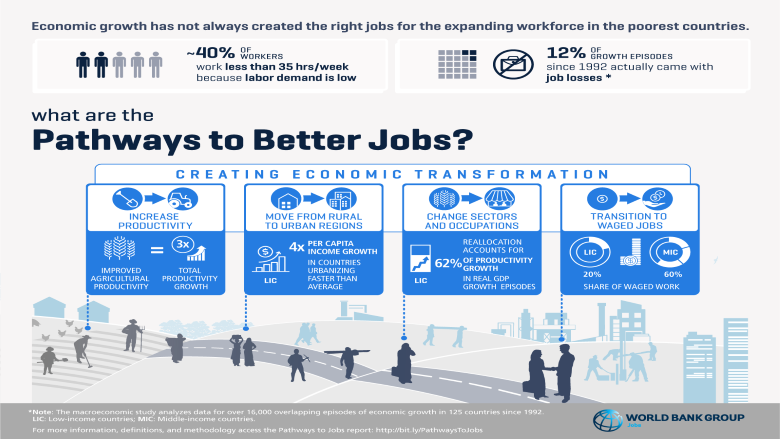In low-income countries, most people work because they cannot afford not to. Labor force participation rates and employment rates are highest in low-income countries. In lower-middle-income countries, inactivity is higher and unemployment rates lower.
Underemployment, not unemployment, is the main challenge for many low-income countries. On average, 40 percent of employed workers work fewer than 35 hours per week in low- and middle-income countries. On the other hand, around a third of employed people in low-income countries work over 45 hours a week, indicating that hourly productivity is low, so they need to work long hours to survive.
Inactivity for women is lowest in low-income countries, but rises in lower-middle-income countries,and then drops again for upper-middle-income countries.
Economic growth has not always created the right number and distribution of jobs for the expanding workforce in International Development Association (IDA) countries -the world's poorest countries.There is no guarantee that economic growth will be labor intensive, nor that productivity gains will be shared by all workers. What drives GDP growth is productivity growth. Growth can be more inclusive when it is labor intensive, so more workers experience gains in their productivity by moving to better jobs.
Economic transformation is the main driver of productivity growth in low-income countries. 80 percent of labor productivity growth in low-income countries comes from the reallocation of labor from lower-productivity agriculture into relatively higher-productivity services and industry.
Raising agricultural productivity is critical in catalyzing growth and economic transformation in low and lower-middle-income countries. When agricultural productivity is growing, labor moves out of agriculture and GDP growth is faster. The opposite is also true. When agricultural productivity is falling, labor is moving into agriculture: family members return to the farm, which reduces agricultural productivity and lowers economic growth.
The gains in economic transformation in low- and lower-middle-income countries are limited by the prevalence of low-productivity self-employed and service activities. During the growth episodes in low-income countries analyzed for this report, more workers typically moved into services than into industry.
Urbanization, especially in secondary cities, is a key complement to sectoral transformation in low and middle-income countries. In low-income countries, the growth in the share of the urban population in secondary towns and cities is double that of the primary city. In low-income countries that are urbanizing faster than average, labor reallocation from agriculture adds four times as much to per capita income growth as it does in countries with slower than average urbanization.
The share of waged employment in total employment is lowest in low-income countries and is progressively higher for lower-middle-income countries and upper-middle-income countries. For countries with annual per capita income below $600, this share is about 20 percent; it reaches 63 percent of employment in middle-income countries. This suggests that the creation of waged employment is an important aspect of the economic transformation countries make as they progress toward higher per capita income.
The growing share of wage jobs observed as countries become less poor includes both informal and formal jobs. The share of wage employment is steadily increasing with GDP per capita for low and middle-income countries, due almost solely to increases in formal wage employment, which accounts for about 20 percent of all employment types at around $250 per capita and increases to around 55 percent at about $14,000 per capita.
In the private sector, job creation comes from new and young firms; large firms are significant employers, but micro firms tend not to expand employment. In many countries, micro firms are the majority. But large firms are significant employers of waged workers, and they pay higher wages. Micro firms tend to employ only family members.
Public sector waged employment in low- and lower-middle-income countries is a significant share of total waged employment. Public sector waged workers account for about 40 percent of waged work on average (45 percent in low-income countries). Since most waged jobs in the public sector are teachers, nurses, police, and soldiers, these jobs provide careers and social mobility for many members of society and are important jobs in development.


